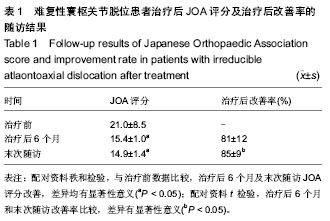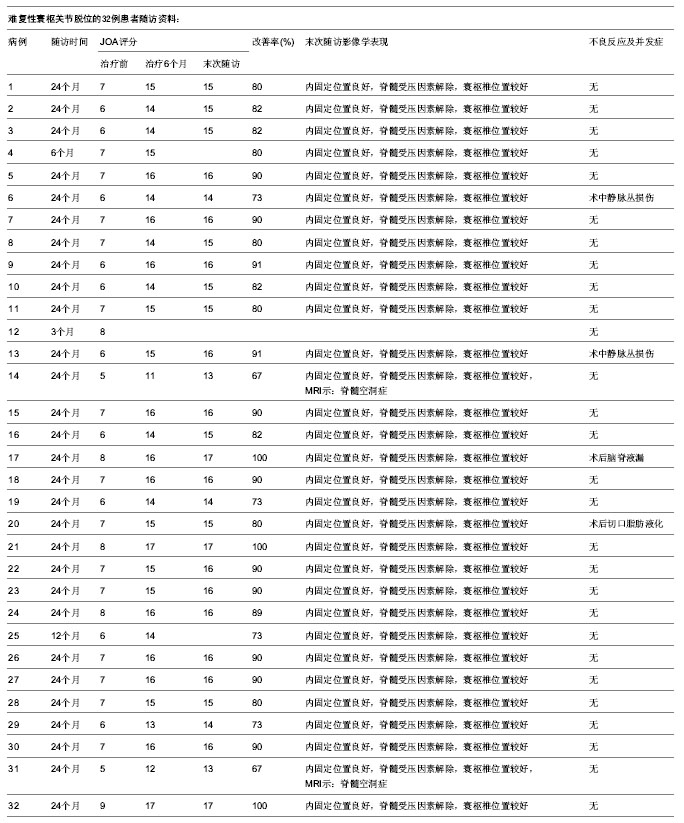| [1] Dickman CA, Locantro J, Fessler RG.The influence of transoral odontoid resection on stability of the craniovertebral junction.J Neurosurg. 1992;77(4):525-530.[2] 尹庆水,刘景发,夏虹,等.经口咽前路枢椎体次全切除椎管减压术[J].中国脊柱脊髓杂志,2004,14(1):9-11.[3] 杨双石,刘景发,吴增晖,等.经口咽入路治疗枕颈部病变(附43例)[J].中国矫形外科杂志,2000,7(11):1071-1073.[4] 金明熙,谢林,李小川,等.颈椎管单开门术后颈椎稳定性变化及其对术后效果的影响[J].中国医科大学学报,2000,29(增):75.[5] Melcher RP, Puttlitz CM, Kleinstueck FS,et al.Biomechanical testing of posterior atlantoaxial fixation techniques.Spine (Phila Pa 1976). 2002;27(22):2435-2440.[6] Yin Q, Ai F, Zhang K,et al.Irreducible anterior atlantoaxial dislocation: one-stage treatment with a transoral atlantoaxial reduction plate fixation and fusion. Report of 5 cases and review of the literature.Spine (Phila Pa 1976). 2005;30(13): E375-381.[7] 罗发明,黄思庆,裴福兴,等.枕颈后外侧入路显露枢椎齿突的应用解剖[J].中华骨科杂志,2000,20(2):75-78.[8] Finn MA, Bishop FS, Dailey AT.Surgical treatment of occipitocervical instability.Neurosurgery. 2008;63(5):961-968.[9] Pratt H, Davies E, King L.Traumatic injuries of the c1/c2 complex: computed tomographic imaging appearances.Curr Probl Diagn Radiol. 2008;37(1):26-38.[10] 陈晓雷,刘宁,朱风仪,等. 经口咽入路治疗颅颈区腹侧畸形的解剖及临床研究[J]. 南京医科大学学报:自然科学版,2008, 28(5): 673-676.[11] Naderi S, Pamir MN.Further cranial settling of the upper cervical spine following odontoidectomy. Report of two cases.J Neurosurg. 2001;95(2 Suppl):246-249.[12] Menezes AH.Surgical approaches: postoperative care and complications "transoral-transpalatopharyngeal approach to the craniocervical junction".Childs Nerv Syst. 2008;24(10): 1187-1193.[13] 乔广宇,张远征,余新光,等.经口咽入路行延髓-颈髓腹侧减压治疗颅颈交界区畸形[J].军医进修学院学报,2010,31(4):309-311.[14] Goto S, Mochizuki M, Kita T,et al.Transoral joint release of the dislocated atlantoaxial joints combined with posterior reduction and fusion for a late infantile atlantoaxial rotatory fixation. A case report.Spine (Phila Pa 1976). 1998;23(13): 1485-1489.[15] Tong FC, Cloft HJ, Joseph GJ,et al.Transoral approach to cervical vertebroplasty for multiple myeloma.AJR Am J Roentgenol. 2000;175(5):1322-1324.[16] 王健,倪斌.经口手术入路治疗颅颈交界区病变[J].中国脊柱脊髓杂志, 2005,15(1):52-53.[17] 王超,阎明,周海涛,等.难复性寰枢关节脱位的手术治疗[J].中华骨科杂志,2004,24(5):290-294.[18] 尹庆水,刘景发,夏虹,等.经口咽前、后路一期手术治疗难复性寰枢椎脱位伴脊髓压迫症[J].中国脊柱脊髓杂志,2001,11(2): 100-102.[19] 韩伟,田晓滨,李波,等.经口咽入路治疗陈旧性寰枢关节脱位12例疗效观察[J].贵州医药,2008,32(10):924-925.[20] 肖嵩华,毛克亚,王岩,等.前后路手术治疗颅颈交界区疾病[J].脊柱外科杂志,2009,7(1):1-3.[21] 姜文涛,翟明玉,方华宴.前后路一期手术治疗难复性寰枢关节脱位13例[J].人民军医,2012,55(4):328-329.[22] 王健,倪斌.经口手术入路治疗颅颈交界区病变[J].中国脊柱脊髓杂志,2005,15(1):52-54.[23] 胥少汀,葛宝丰,徐印坎.实用骨科学[M].4版.北京:人民军医出版社,2012.[24] 刘忠军,陈仲强,郭昭庆,等.脊柱外科手术操作与技巧[M].北京:人民卫生出版社,2009.[25] 中华人民共和国国务院.医疗机构管理条例.1994-09-01.[26] 李世民,党耕町.临床骨科学[M].天津:天津科学技术出版社, 1998:629.[27] Veres R, Bagó A, Fedorcsák I.Early experiences with image-guided transoral surgery for the pathologies of the upper cervical spine.Spine (Phila Pa 1976). 2001;26(12): 1385-1388.[28] Tong FC, Cloft HJ, Joseph GJ,et al.Transoral approach to cervical vertebroplasty for multiple myeloma.AJR Am J Roentgenol. 2000;175(5):1322-1324.[29] Menendez JA, Wright NM.Techniques of posterior C1-C2 stabilization.Neurosurgery. 2007;60(1 Supp1 1):S103-111.[30] Tubbs RS, Webb D, Smyth MD,et al.Magnetic resonance imaging evidence of posterior pharynx denervation in pediatric patients with Chiari I malformation and absent gag reflex.J Neurosurg. 2004;101(1 Suppl):21-24.[31] 陈耿,韩立新,曹惠霞,等.经口咽前路寰枢椎复位钢板置入内固定治疗颅颈交界部畸形的MRI评价[J].中国组织工程研究与临床康复,2010,14(48):9003-9006.[32] 尹庆水,刘景发,夏虹,等.经口咽前路枢椎体次全切除椎管减压术[J].中国脊柱脊髓杂志,2004,14(1):9-11.[33] 郝定均,贺宝荣,雷伟,等. Cervifix在陈旧性寰枢椎脱位并高位颈髓压迫症中的应用[J].中国矫形外科杂志,2004,12(18):1365- 1368.[34] Weng C, Wang LM, Wang WD,et al.Bipartite atlas with os odontoideum and synovial cyst: case report and review literature.Spine (Phila Pa 1976). 2010;35(12):E568-575.[35] 尹庆水,刘景发,夏虹,等.经口咽前、后路一期手术治疗难复性寰枢椎脱位伴脊髓压迫症[J].中国脊柱脊髓杂志,2001,11(2): 100-102.[36] Jones DC, Hayter JP, Vaughan ED,et al. Oropharyngeal morbidity following transoral approaches to the upper cervical spine.Int J Oral Maxillofac Surg. 1998;27(4):295-298.[37] Kelly BP, Glaser JA, DiAngelo DJ.Biomechanical comparison of a novel C1 posterior locking plate with the harms technique in a C1-C2 fixation model.Spine (Phila Pa 1976). 2008;33(24): E920-925. [38] Ma XY, Yin QS, Wu ZH,et al. Anatomic considerations for the pedicle screw placement in the first cervical vertebra.Spine (Phila Pa 1976). 2005;30(13):1519-1523.[39] Igarashi T, Kikuchi S, Sato K,et al.Anatomic study of the axis for surgical planning of transarticular screw fixation.Clin Orthop Relat Res. 2003;(408):162-166.[40] Bransford RJ, Russo AJ, Freeborn M,et al.Posterior C2 instrumentation: accuracy and complications associated with four techniques.Spine (Phila Pa 1976). 2011;36(14):E936- 943. [41] Lapsiwala SB, Anderson PA, Oza A,et al. Biomechanical comparison of four C1 to C2 rigid fixative techniques: anterior transarticular, posterior transarticular, C1 to C2 pedicle, and C1 to C2 intralaminar screws.Neurosurgery. 2006;58(3): 516-521. |


